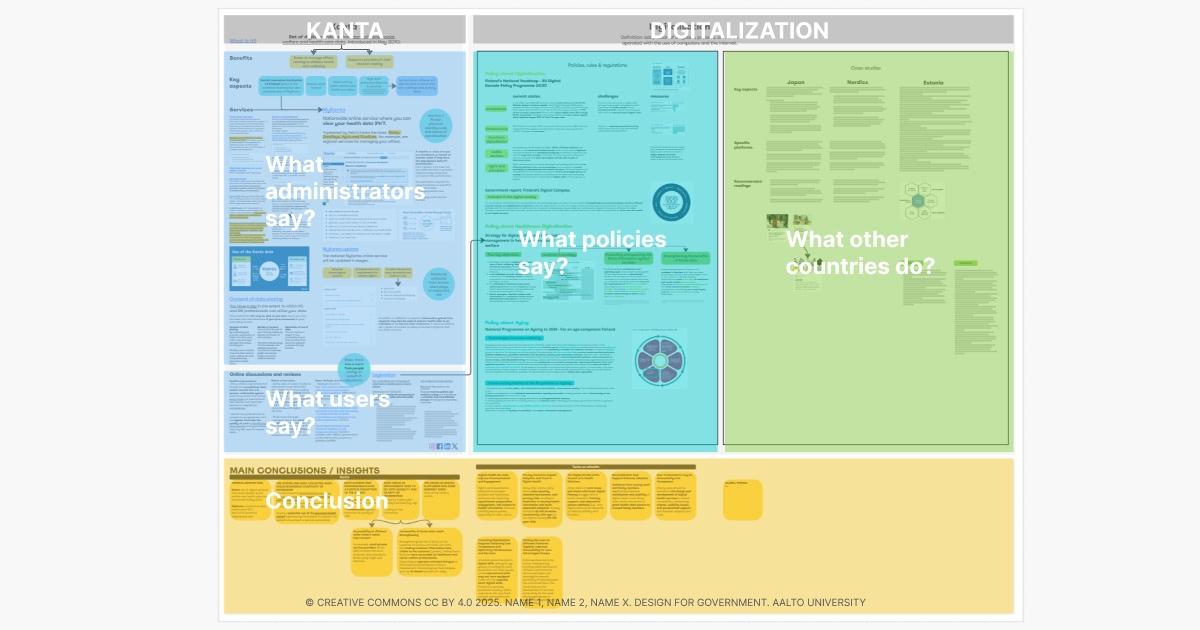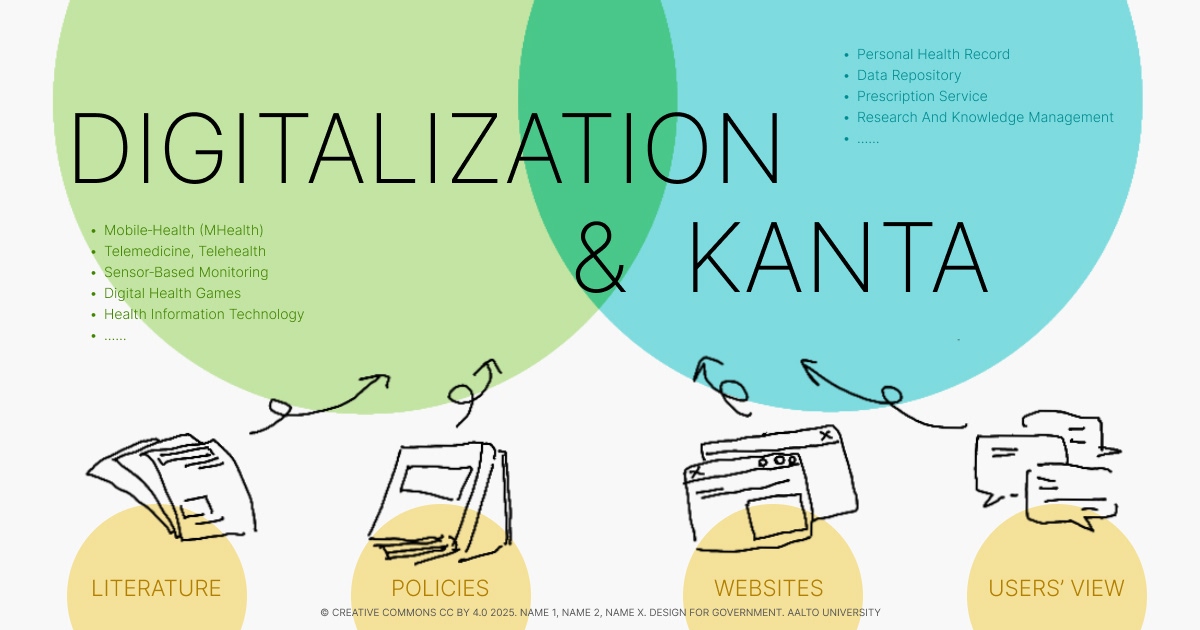This blog post reports on work-in-progress within the DfG course! The post is written by the ‘Digitalization and Kanta’ workstream dealing with Kela, the Social Insurance Institution of Finland’s brief on ‘Continuity of Knowledge’. The group includes Yue Yu and Francesca Martini from the Creative Sustainability program (Aalto).
Written by: Yue Yu
Introduction
This is the first blog of the Digitalization and Kanta Workstream. It presents the desktop research that breaks down broad topics into national policies, stakeholders’ views, and international cases. We reorganize complex information to gain an initial understanding of the context, as well as research plans for the next steps.
Seeing both sides of the coin: the users and the providers
The healthcare system worldwide is facing challenges such as population aging, economic constraints, and technological transformation (Jormanainen et al., 2023). As electronic infrastructures and technologies develop, digitalization has become a potential solution. Kanta, being a representative digital service system in Finland, consists of a set of digital services that store citizens’ social welfare and healthcare data, such as personal health record and prescription services. It was introduced in May 2010, with the Social Insurance Institution of Finland (Kela) serving as its technical implementer and administrator. How it works in practice is that data is uploaded to the platform by both public and private providers and is available for users to access at any time. It supports not only appointment preparation, engagement, and access to health information for users, but also research for professionals. Therefore, this system adds value to the continuity of knowledge, which is to make useful information transferring seamlessly across healthcare providers, regions, and support networks, by centralizing information from various regions and healthcare institutions together. To understand our topic, Digitalization and Kanta better, we collected information from both the user and provider perspectives. The data sources included policy documents, website information, academic literature, and user comments on social media. Apart from Finland, we also explored cases from Japan, Estonia, and Nordic countries, to gain a broader perspective.

Figure 1: Research structure and findings
The inclusiveness of digitalization
Although promoting digital services can reduce service costs and ease the workload of healthcare workers, this solution brings along disadvantages, especially for aging groups (Strategy for Digitalization and Information Management in Healthcare and Social Welfare, 2024). According to Finland’s Digital Compass, advancing digitalization involves four key areas: skills, infrastructure, public services, and business (Finland’s National Roadmap: EU Digital Decade Policy Programme 2030, 2024). The aging groups may struggle with digital services as their educational path might not equip them with the requisite basic digital skills, making it harder to use electronic devices and online services. The user experience of interfaces and the clarity of information still need improvement, since for the aging groups, functional limitations such as vision deterioration, hearing impairment, and memory loss can obstruct the use of digital platforms (Heponiemi et al., 2024). To address these issues of accessibility and acceptance, user involvement is the key. The aging groups and professionals, for example, can be included in the design and development of digital health services to ensure accessibility. Additionally, due to Finland’s sparsely distributed population, rural areas often lag behind urban regions in terms of infrastructure. Moreover, the digitalization of health data has raised concerns about data security, such as errors, leakage, and fraud. Therefore, strategic planning and system architecture from the organizational perspective are also essential.
To be centralized or fragmented? That is the question
Kanta is a nationwide digital healthcare service platform for Finland. However, there are also other websites and services for accessing and managing health information. Maisa, OmaTays, Hyvis, and SiunSote, for example, are regional platforms for managing healthcare affairs. In addition, some nationwide platforms offer similar health information guidance. For instance, Suomi.fi provides social security and health information support for all citizens. These platforms offer comprehensive services in different healthcare areas that are available in different regions. However, they can also lead to information fragmentation, which might confuse the users. How information is presented across various platforms requires front-end design, while the interaction of data in the back-end demands system-level planning from the government and administrators as well.
Next step forward
After conducting desktop research and gaining initial insights into Finland’s digitalization landscape and the current application of Kanta, our next step is translating the findings into discussion topics and key questions for a roundtable discussion to obtain insights from an organizational perspective. The research of digitalization is not a simple task, but we believe that we’ve already had a first glimpse of it. Stay tuned for our next step!
References
Jormanainen, V., Vehko, T., Lindgren, M., Keskimäki, I., & Kaila, M. (2023). Implementation, Adoption and Use of the Kanta Services in Finland 2010-2022. Studies in Health Technology and Informatics, 302, 227–231. https://doi.org/10.3233/SHTI230108
Finland’s National Roadmap: EU Digital Decade Policy Programme 2030. (2024). Finnish Government.
Strategy for digitalisation and information management in healthcare and social welfare. (2024). Ministry of Social Affairs and Health. https://julkaisut.valtioneuvosto.fi/handle/10024/165362
Heponiemi, T., Virtanen, L., Kaihlanen, A.-M., Kainiemi Päivikki Koponen, E., & Koskinen, S. (2024). Use and changes in the use of the Internet for obtaining services among older adults during the COVID-19 pandemic: A longitudinal population-based survey study. New Media & Society, 26(6), 3146–3167. https://doi.org/10.1177/14614448221097000
The DfG course runs for 14 weeks each spring – the 2025 course has now started and runs from 24th Feb to 27th May. It’s an advanced studio course in which students work in multidisciplinary teams to address project briefs commissioned by governmental ministries in Finland. The course proceeds through the spring as a series of teaching modules in which various research and design methods are applied to address the project briefs. Blog posts are written by student groups, in which they share news, experiences and insights from within the course activities and their project development. More information here about the DfG 2025 project briefs. Hold the date for the public finale on Tuesday 27th May!

